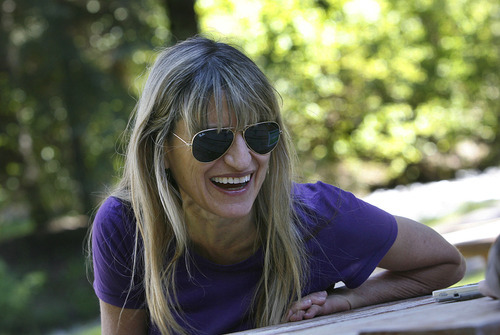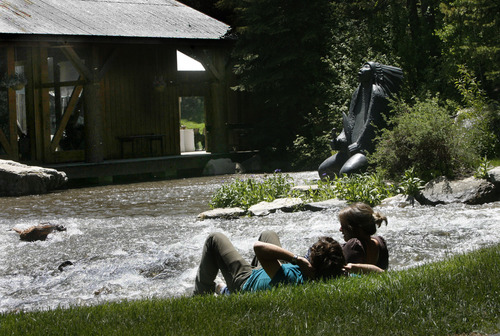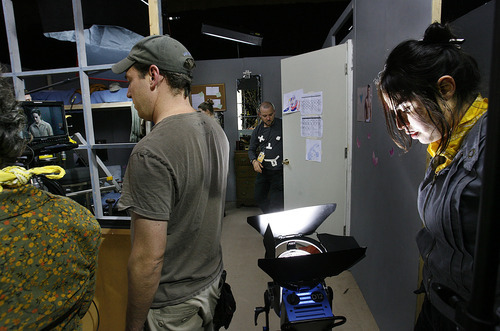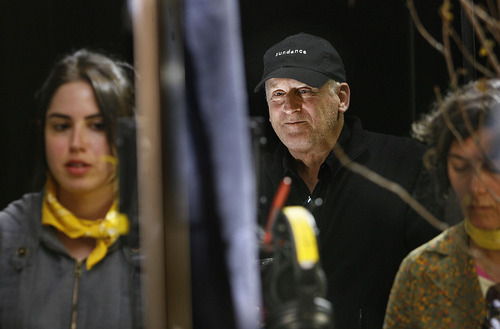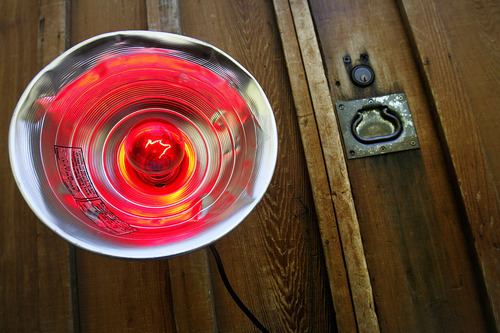This is an archived article that was published on sltrib.com in 2011, and information in the article may be outdated. It is provided only for personal research purposes and may not be reprinted.
Sundance Resort • Eight Hollywood heavyweights crowd into a single trailer, one that's smaller than the mobile palaces most of them could demand, if they so chose, on a big-budget movie set.
The trailer is an editing room, a temporary facility on the grounds of Robert Redford's Sundance resort in Provo Canyon. It is part of the toughest summer camp in the movie business: The Sundance Institute's June Filmmakers Lab.
On this Friday afternoon, Mexican director Yolanda Cruz is in the editing room, working with an editor to piece together a scene shot the day before in Sundance's rehearsal hall. The scene depicts an emotionally tricky moment, involving a Mexican mother and her young son who is just realizing that his father who went to the United States has abandoned them.
The eight advisors are watching the rough cut for the first time, ready to provide feedback. The heavyweight advisors jammed into this trailer are: actor Sally Field, directors Catherine Hardwicke ("Twilight"), Jeremy Kagan ("The Journey of Natty Gann"), Kasi Lemmons ("Eve's Bayou") Keith Gordon ("Mother Night"), and editor William Goldenberg (who just completed work on the new "Transformers" movie).
But Cruz speaks first, thanks to the respect offered by Michelle Satter, who has been in charge of Sundance's Feature Film Program since its inception in 1981. Satter asks: "Is there anything specific you want from us?"
In that moment, Satter defines what the Sundance labs are about: Being there to support the filmmaker, but letting the filmmaker decide how much support is needed.
—
A place to experiment • The labs are "the core of Sundance," Robert Redford underscored this month at a Beverly Hills fundraiser for the Sundance Institute. "Everything that has come from that, started there."
If the world-famous Sundance Film Festival held each January in Park City is the showroom for independent film, the labs are where the research-and-development work happens.
Sundance labs, including the Feature Film Program that's marking its 30th anniversary, help young filmmakers get their scripts off the ground. At the Filmmakers Lab each June, eight directors get to workshop scenes from their scripts — with real film crews, professional equipment and name actors — in a pressure-free setting, with movie veterans (including Redford) serving as advisers.
After three weeks of hands-on filmmaking work, those eight directors are joined by six more screenwriters for a week-long intensive lab that focuses on writing. (Another screenwriting lab happens every January, just before the film festival.)
Experimentation is encouraged, because the scenes shot and edited in the labs, and the comments given by the institute's advisers won't surface outside the resort. What happens at Sundance stays at Sundance.
"I'm loving this lab," said Satter, sitting at a picnic table on a June afternoon as the higher-than-usual Provo River rushed behind her through the resort. "I feel like all the filmmakers are in the right place. They've embraced Sundance as a safe place to work."
—
'An offer I couldn't refuse' • Art has always been part of Michelle Satter's life.
Her father, Warren (who died in May at the age of 90), was a painter whose work was exhibited in galleries on the Jersey Shore. Her mother, Helen, who escaped from Prague during World War II, was interested in theater and music.
As a kid, Satter studied dance. In college, she spent her afternoons at the Orson Welles Cinema, a repertory house in Cambridge, Mass., that played films by Godard, Truffaut and Fellini, as well as indie films that were labeled "regional films."
In 1981, Michelle Satter was working at Boston's Institute of Contemporary Art, doing public-relations and organizing theater and film programs. A programmer at the Orson Welles recommended her to people at Sundance, who were organizing the first summer lab.
"I got a call, saying 'What are you doing the month of June?'" Satter recalled. She was asked to organize a conference on distribution. "It was an offer I couldn't refuse."
"The first day of that month, I thought, 'I want to stay here,'" Satter said. "It was amazing, unlike anything I'd ever done." She met with Redford and Sterling Van Wagenen, then the director of the Sundance Institute (and, at the time, Redford's brother-in-law), about moving to Los Angeles and working full-time for Sundance.
"Redford said, 'Sure, call me when you get there,'" Satter said.
The first lab, Satter said, was overly ambitious. It included a producer's conference (which Sundance now runs separately in the summer), and the writers' lab was scheduled before the directing lab. The current set-up, with the writers' lab following the directing lab, allows the directing fellows "to take all they've learned and put it all together," Satter said.
That first lab had one notable success: Gregory Nava's "El Norte," the acclaimed 1983 drama about Guatemalan immigrants seeking refuge in the United States.
Since then, the Sundance Filmmakers' Lab has launched quite a few careers.
Quentin Tarantino ("Reservoir Dogs") and Paul Thomas Anderson ("Hard Eight") worked on their first movies at Sundance. So did Kimberly Peirce with "Boys Don't Cry," John Cameron Mitchell with "Hedwig and the Angry Inch," Miranda July with "Me and You and Everyone We Know," and Cary Fukunaga with "Sin Nombre."
Even J.F. Lawton's script for "Pretty Woman" got its start at the Sundance labs — though then it was titled "3,000" (a reference to Julia Roberts' character's asking price), and the prostitution story went through some rewrites to make it more of a romantic crowd-pleaser.
In addition, Sundance's reach has expanded internationally: This year's lab includes directors from Mexico, Israel and Romania, and writers from Algeria and the Philippines.
"We're making bolder choices," Satter said. "It's always been about diversity and promoting voices that haven't always been heard."
—
Working out problems • On an artificially smoky set in Sundance's rehearsal hall, Romanian director Bodgan Mustata is making his own bold choice: Should his actor pick up a picture frame or not?
The scene Mustata is shooting, from his family drama "Wolf," has a father (played by James Urbaniak here in the lab) and son (played by Devon Bostick) confronting each other over a picture on the wall. The son holds the picture frame, then tries to hand it to the father. The father drops it, and when the son kneels down, the father pushes him to the ground.
On one take, though, Urbaniak (who played R. Crumb in "American Splendor," and is famous among geeks as the voice of Dr. Venture on the Adult Swim cartoon "The Venture Bros.") stops in the middle of the scene. Bostick (who played the older brother Rodrick in the "Diary of a Wimpy Kid" films) had picked up the frame, a move that hadn't been rehearsed.
Mustata and the actors talk to clarify a few small but important details: Should the son pick up the frame? Is there supposed to be broken glass on the floor? At what point should the father push the son?
The conversation reaches a satisfying conclusion, the crew pumps another burst from the smoke machine — all the better to catch the light streaming in from the window — and the actors shoot the scene again.
—
Life (make that career) changing • Elsewhere in the rehearsal hall, four walls and some bunk beds stand in for an Israeli army barracks. There, director Talya Lavie is working on a scene from her script, "Zero Motivation," a comedy-drama about three young clerks at a remote Israeli army base. The story was inspired by Lavie's own experiences as a conscript, as a term of military service remains mandatory for Israelis.
The scene illustrates the rift between friends Daffi (Danielle Panabaker, from "Sky High") and Zohar (Alia Shawkat, from "Arrested Development" and "Cedar Rapids"), when Daffi is promoted to officer and must give Zohar orders. The scene has some intricate blocking, and the actors must hit their marks and convey tough emotions at the same time.
Lavie's military experience gave "her a great command of the crew," says Catherine Hardwicke, the "Twilight" director who's on her third stint as a Sundance adviser. "She's a pretty kick-ass chick."
Sundance advisers are taught early on to listen as much as talk, and only to give advice where it's needed. "With some, I say I can't presume to advise you," Hardwicke said. "Maybe I can offer a few tips, give some stories about how I got money to make my movies. ... We don't want to impose our will on a personal vision."
Advising at Sundance is a chance for successful Hollywood players to return the favor. Hardwicke's first movie, the gritty teen drama "Thirteen" with Evan Rachel Wood and Holly Hunter, debuted at the Sundance Film Festival. "It changed my life," Hardwicke said.
"We go through the struggles to get movies made, all the disappointments," Hardwicke said. "Here, you don't talk about the business stuff. It gets you excited about filmmaking again." The director, whose "Red Riding Hood" hit theaters in March, said she has been inspired by being at Sundance to work on a new low-budget script.
The advisers also network. Hardwicke said she's working on a boxing movie, so she didn't miss the chance to confer with William Goldenberg, who edited Michael Mann's "Ali." In the lab's early days, according to Redford biographer Michael Feeney Callan, director Barry Levinson came as an adviser — and in return got Redford to consider Levinson's next movie, "The Natural."
—
Challenge of the storytelling • Satter is quick to credit the success of the Sundance lab to others, from the advisers to her staff.
"Basically, I've been lucky," Satter said when asked about her longevity at Sundance. "I am constantly moved by the stories that they are telling here."
But others credit Satter for keeping the vision of Sundance constant. "She's one of the most unique human beings on the whole planet. She sticks to her truth, her ideas," Hardwicke said. "She challenges us, and drives us to see the positive side."
Afton White, a 23-year-old Brigham Young University art-history major from Los Angeles, has watched Sundance literally her whole life. She came to the labs as a small child, when her father worked as an assistant editor. Now she's working in her third lab, as a set dresser ("they call us 'art dogs,'" she said), and she is considering art direction as a possible career.
Satter, White said, "really knows what she's talking about. She's really supportive, not just of the directors but also of the crew."
Satter doesn't have much time for reflection on her 30 years running the Sundance labs: "I live in this year." She sees the work at this summer's labs, and the Institute's year-round support that has grown from them, as a continuation of what Redford started in 1981.
"This lab, in our 30th year, reflects the original intention: To give artists the chance to fully explore their scripts," Satter said. "The mission of 30 years ago lives with us today."
Twitter: @moviecricket
Redford on Satter
Sundance Institute founder Robert Redford praised Michelle Satter, the founding director of Sundance's Feature Film Program, and presented her with Sundance's Vanguard Award at a June 8 fundraiser in Beverly Hills.
An excerpt from Redford's speech
"That group that I started with, it was very lean and mean. I'd like to now move even closer to the labs, and point out a particular person who I love dearly, who's been a friend and a compatriot for a long time, and that's Michelle.
"Michelle came in about a year after we started [the institute]. She came out of Boston, she was a research analyst, and she was full of electric energy and a keen intellect and a great passion. I don't know how she got there, but I'm glad she got there. She became committed, and that commitment has developed along with our lab process for years and years and years.
"All you artists who are here tonight know exactly what I'm talking about when I talk about her value. How vital she was to our process, how she helped shape and refine the process during some very difficult times — because it was a rollercoaster ride for years — and how she stayed with it. And her nurturing, and her passion and her commitment have been unparalleled."


